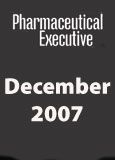The $4 Billion Cyber Fraud
The proof is in the metrics. Last June, MarkMonitor sifted through 60 million e-mail messages and billions of Web pages to get a handle on how six major brand-name drugs were being touted and sold on the Internet. In the process, it found nearly 3,200 online pharmacies selling those drugs, according to the Summer 2007 MarkMonitorBrandjacking Index. But only four-count 'em-of these e-stores carried the respected Verified Internet Pharmacy Practice Site (VIPPS) accreditation.
The proof is in the metrics. Last June, MarkMonitor sifted through 60 million e-mail messages and billions of Web pages to get a handle on how six major brand-name drugs were being touted and sold on the Internet. In the process, it found nearly 3,200 online pharmacies selling those drugs, according to the Summer 2007 MarkMonitorBrandjacking Index. But only four—count 'em—of these e-stores carried the respected Verified Internet Pharmacy Practice Site (VIPPS) accreditation.
There is no mystery behind the pharmacies' motivation. This year, pharmaceutical sales hit $305 billion in the United States and $609 billion worldwide, according to estimates by IDC's Health Industry Insights. Clearly, there is big money to be made in trading on someone else's good brand. What the buyers actually get for their money, however, is anybody's guess.

Frederick Felman
Many of the proprietors of these pharmacies appear to know what they're doing when it comes to sales and promotion. They employ classic direct-marketing techniques to lure visitors to their sites, even using some 110,000 landing sites—Web pages intended to convert Web surfers into customers—to test their pitches for different demographic audiences. While the daily average number of landing sites was 6,000, on some days the number spiked to 11,000.
The brands picked for the survey were household names advertised on national TV. Half were garnered from Drug.com's top-selling brands for 2006, and half from the most-searched drug brands online in June. While they cannot be named here, they are big, important brands, developed and marketed by big, important companies. And now other organizations want to profit from them.
Big Numbers Mean Big Trouble
Unquestionably, many of these sites promote fake, stolen, diluted, or gray-market drugs. But the quality of some of the Web presences is such that even an expert would be hard-pressed to tell that they are spurious.
When it comes to the actual sale of these "branded drugs," things get even scarier. Less than 10 percent of the 3,160 online pharmacies required any prescription to move what are supposed to be prescription-only medications. Many marketers touted a no-prescription policy in their pitches.
More than half—59 percent—of the online pharmacies are hosted in the United States; the United Kingdom came in second, at 18 percent. Some of these marketplaces must be bustling. A third of the pharmacies generated enough traffic to garner Alexa ratings. (Alexa is a service that computes Web traffic statistics by analyzing usage of millions of users who run the Alexa toolbar and is a widely accepted measure of Web site popularity.)
Using this publicly available information, MarkMonitor was able to make some well-informed estimates about the amount of business flowing through these pharmacies. It put the figure of daily visitors at 32,000. In the aggregate, MarkMonitor estimated that 32 million people hit these Alexa-ranked sites daily during the four-week period in question.
To estimate a dollar amount of sales, MarkMonitor assumed that 0.5 percent of the online shoppers ended up buying something. It then assumed an average purchase price of $70. That would put annual sales at $4 billion a year.
Enter at Your Own Risk
It is clear from those figures that both corporate profits and brand equity are at stake here. But there is a serious—and growing—public-health risk as well. With pills selling online for a tiny fraction of their retail price, it is likely that they are not genuine—and the ramifications of that can be dire.
In the most extreme and widely reported case, a 57-year-old Canadian woman died late last year after taking pills she bought online. The drugs, which were sold as anti-anxiety medications and sedatives, contained uranium, strontium, selenium, aluminum, barium, and boron, according to subsequent news reports. At the time of her death, just after Christmas, the Canadian Pharmacists Association warned that nearly half of all drugs bought from online pharmacies could be counterfeit or otherwise substandard. The pills in this case were purchased from a Web site claiming to be a legitimate Canadian supplier.
While it's hard to tell without actually testing the drug in question whether it's fake, diluted, or even poisoned, some reasonable conclusions can be drawn from the price data. For example, MarkMonitor researchers compared the sale of one drug by both certified and noncertified online pharmacies. It found that the nonaccredited sites offered it for $2.72 while the certified competitors charged $10.85. The noncertified entities were somehow able to offer a whopping 75 percent discount. This would strongly imply that the medication was not kosher.
Another site promoted itself as a Canadian pharmacy when, in fact, it originated in Russia and had faked its accreditation. It was selling individual prescription pills that are not legitimately available in individual pill quantities. In cases like this, it's clear that the prospective buyer does not know who is selling or what is being sold.
Personal data of unsuspecting buyers is also at risk. Nearly half of the online pharmacy sites surveyed did not implement even the most rudimentary security. There was no Secure Socket Layer (SSL), no encryption. Researchers found that a fifth of post-purchase e-mail messages captured had links to unprotected consumer data. A customer putting in credit card or other information is playing roulette with that information.
The High Cost to Pharma
The drug brand-abuse problem extends beyond the world of consumer distribution right up into the pharmaceutical supply chain itself. During the four weeks of the survey, MarkMonitor found nearly 400 business-to-business exchanges listing the six brands. Twenty-one of the exchanges listed price information, and the numbers shed light on possible vulnerabilities in, or corruption of, the drug supply chain.
Many prices posted for the drugs were too low to be true—at least for legitimate drugs. One of these exchanges listed the availability of 75 million pills for $2 each, or $150 million total. The chance of this being a legitimate pharmaceutical exchange was virtually nil. Again, this would suggest that the goods being proffered are not the real deal. China hosts nearly a third (31 percent) of these exchange-site listings; the United States, 26 percent; and India, 19 percent.
The net takeaway here is that both wholesale and retail sites are claiming to sell branded goods that are anything but. At best, these drugs are innocuous placebos or copies; at worst, they can be health- and even life-threatening.
For a corporation that has spent time and money building up a legitimate and beneficial pharmaceutical brand, these online threats are very real. And even though the drug firms are not involved in this activity, the use of their closely watched brand names by outside interests beyond their control hurts their credibility and customer relationships.
Pharmaceutical companies that develop and promote branded drugs have a duty to themselves and their customers to patrol their brands in the digital distribution channels just as they do in their physical channels and to help keep bad or outdated drugs from entering the supply chain. They must proactively monitor what is happening with their brands online, identify potential abuse early, and nip it in the bud.
Frederick Felman is the chief marketing officer at MarkMonitor. He can be reached at ffelman@markmonitor.com

Navigating Distrust: Pharma in the Age of Social Media
February 18th 2025Ian Baer, Founder and CEO of Sooth, discusses how the growing distrust in social media will impact industry marketing strategies and the relationships between pharmaceutical companies and the patients they aim to serve. He also explains dark social, how to combat misinformation, closing the trust gap, and more.
The Misinformation Maze: Navigating Public Health in the Digital Age
March 11th 2025Jennifer Butler, chief commercial officer of Pleio, discusses misinformation's threat to public health, where patients are turning for trustworthy health information, the industry's pivot to peer-to-patient strategies to educate patients, and more.